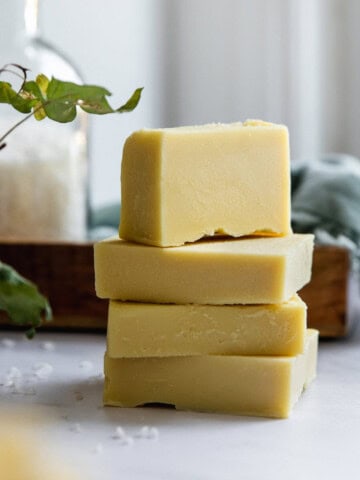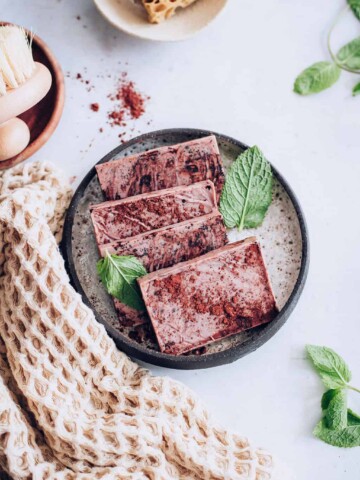Ready for soap that does double duty? Then, I’d like you to meet my newest skin obsession: an all-natural, head-to-toe beauty bar infused with turmeric, raw honey, and witch hazel. This extra-gentle turmeric soap is superfatted, meaning it contains additional plant butters and oils to help hydrate as it cleanses.
And it’s loaded with skin-loving botanicals to soothe irritation and treat problem skin anywhere on the body. Because it’s so gentle, you can use it as a facial cleanser, body wash, even as a nourishing hand soap, and just about anything in between.

Benefits of Turmeric Soap
If you’ve hung around here long enough, you’d know that we have a thing for turmeric. It’s one of the few spices scientifically proven for soothing inflammation [source], encouraging wound healing, and modulating skin health [source], so we’re keen on throwing it in just about everything.
And lately, one of our favorite ways to use it is in soap.
In Ayurveda, turmeric has been used for centuries to help with things like:
-Slowing the appearance of aging
-Encouraging wound healing
-Soothing a variety of common skin conditions, such as eczema and psoriasis
-Treating breakouts
-Fading discoloration
-Decreasing the appearance of scars
-Brightening skin
When combined with the nourishing oils in homemade cold process soap, turmeric helps cleanse and nourish skin while also soothing irritation and treating a variety of minor skin ailments.
Tips for Making Turmeric Soap
Be forewarned: this soap contains a lot of oils—but there’s a good reason for that.
Including extra fats in a soap recipe (referred to as “superfatting”) gives the soap a creamy, hydrating effect, which prevents it from stripping skin of much-needed moisture. Plus, different fats affect the soap’s lathering abilities and hardness, so each oil in this recipe was chosen with a specific purpose in mind.
I also added raw honey and alcohol-free witch hazel to further boost this soap’s beautifying properties.
Witch hazel leaves and bark contain up to 10% tannins, which give it its astringent properties. And it’s long been used as an antibacterial treatment that helps alleviate inflammation caused by acne and eczema [source].
Meanwhile, raw honey is rich in phenolic compounds, enzymes, and sugars that are said to have antioxidant, anti-inflammatory, and antimicrobial properties. Applying honey directly to the skin may help accelerate wound healing and soothe skin inflammation [source].
I also decided to skip the essential oils this time. While you’re free to use them, sometimes adding extra ingredients or essential oils can cause unforeseen skin irritation or reactions, and I wanted this soap to be as soothing as possible. If you would like your soap to have a scent, add about 20 drops of a soothing essential oil, such as chamomile or lavender, once your soap reaches a thin trace.
How to Use a Beauty Bar
1. Wet the bar with warm water, and rub it between your hands to create a gentle lather.
2. Apply it to your skin in circular motions, taking care to focus on rough spots, breakouts, or anywhere you need extra hydration.
3. Rinse well and gently pat the skin dry.
4. If your skin is especially dry, follow up with moisturizer, serum, or skin oil.
5. To store your bar, put it some place it can dry out thoroughly between uses. Never let it sit in a pool of water.
Turmeric Soap FAQs
Will the turmeric stain my tub or sink?
I found that the bright orange color of the batter lessened considerably over time as the soap cooled. After cutting my bars and setting them out to cure, the color faded even more. So no, I don’t believe that the turmeric in this soap is enough to stain surfaces.
Can I leave out or replace some of the oils?
When it comes to soap making, it’s not as simple as just leaving out some oils and increasing others. There are all sorts of calculations involved in order to get the right ratio of solid fats, liquid fats, and lye. Rather than just adjusting the oils at random, try using a lye calculator to ensure you’ve got the right ratio of fat to lye.
Why does the soap take 4–6 weeks to finish curing?
This is a rather soft soap, thanks to all the liquid oils in the recipe. Allowing the soap to cure for 4–6 weeks helps it dry out, which makes it last longer.
Turmeric Soap
Equipment
- Cooking thermometer
- Kitchen scale
- Immersion blender
- Rubber spatula
- Measuring spoons
- Measuring cup
- Large heatproof jar or glass jug
- Slow cooker or a non-reactive metal pot
- Soap mold
- White vinegar for spills and cleaning up
- Protective gear goggles, gloves, long sleeves, apron, close-toed shoes
Materials
- 4.4 oz sodium hydroxide (lye)
- 8.4 oz distilled water
- 2 teaspoons turmeric
- 8 oz coconut oil
- 4.8 oz shea butter
- 1.6 oz cocoa butter
- 12.8 oz olive oil
- 4.8 oz sunflower oil
- 0.5 oz raw honey
- 1 oz witch hazel
- 2 teaspoons sodium lactate (optional, helps soap release from the mold faster)
- 99% isopropyl alcohol (optional, to prevent soda ash)
Instructions
- Don your protective gear, including gloves, goggles, and long sleeves, and go outside or into a well-ventilted space. Pour the water into a large jar. Then slowly and carefully add the lye.
- Stir until the lye has fully dissolved, and the liquid is mostly clear.
- Add the turmeric and stir again. Set the jar aside to cool for approximately 20–30 minutes.
- Meanwhile, combine all the oils in the base of a crockpot and heat on high, stirring occasionally until just melted (about 20–30 minutes).
- While you wait for the oils to melt, whisk the honey and witch hazel together in a small bowl and set aside.
- Using your cooking thermometer, check the temperature of the oils and the lye water. You want them to be between 110 and 120°F and within 10 degrees of each other, ideally. When the lye water reaches the correct temperature, add 2 teaspoons of sodium lactate to the lye water and stir.
- Then pour the lye water into the slow cooker basin with the melted oils.
- Using your stick blender, blend the mixture until you reach a thin to medium trace (the consistency of loose pudding). Due to the large amount of liquid oils in this recipe, it may take several minutes to reach trace. Add the honey and witch hazel mixture, and continue blending for anouther 30 seconds, or until the mixture reaches a medium trace.
- Pour the batter into the mold and tap on the counter to help get rid of bubbles. Then cover the mold with plastic wrap and set it somewhere it won’t be disturbed. Honey tends to make soap heat up more than normal, so you do not need to insulate the soap—see the notes for more about this.
- Allow the soap to stay in the mold for 2–3 days. Because this is a softer recipe, it may need more time in the mold than normal. Remove from the mold and slice into bars. Allow the bars to cure for 4–6 weeks and enjoy!


















